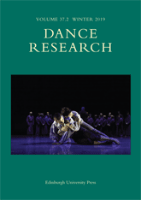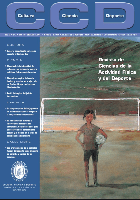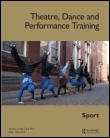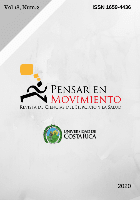
DANCE MAGAZINE
Scope & Guideline
Exploring the Art of Movement Through Expert Perspectives
Introduction
Aims and Scopes
- Diverse Dance Forms and Styles:
The journal covers a wide range of dance styles, from ballet to hip-hop, contemporary to traditional forms, reflecting the rich tapestry of global dance culture. - Health and Wellness in Dance:
A consistent focus on the physical and mental health of dancers, exploring topics such as injury prevention, nutrition, and mental health strategies, ensuring that practitioners prioritize their well-being. - Education and Training:
Insight into dance education, including college programs, workshops, and summer intensives, emphasizing the importance of structured learning and professional development in the field. - Cultural and Social Issues:
Exploration of the intersection of dance with cultural identity, social justice, and inclusivity, addressing the evolving narrative around representation and diversity in the dance community. - Innovations in Choreography and Performance:
Highlighting new trends in choreography and performance, including the incorporation of technology and interdisciplinary collaboration, showcasing the evolving nature of dance as an art form.
Trending and Emerging
- Intersectionality and Representation:
Increased focus on the voices and experiences of marginalized communities within dance, promoting discussions around gender, race, and inclusivity in choreography and performance. - Mental Health Awareness:
A growing emphasis on mental health support for dancers, with articles addressing anxiety, burnout, and the psychological impacts of performance, reflecting a societal shift towards prioritizing mental well-being. - Sustainability and Environmental Awareness:
Emerging discussions on sustainable practices within dance, including eco-friendly production methods and the role of dance in raising awareness about environmental issues. - Digital and Virtual Dance Experiences:
A trend towards exploring digital platforms for dance, including virtual performances and online training, as the industry adapts to technological advancements and audience engagement shifts. - Community and Collaboration:
An emphasis on community-building initiatives within the dance world, promoting collaborative projects and collective creativity among artists, educators, and audiences.
Declining or Waning
- Traditional Competition Structures:
Less emphasis on traditional competitive dance formats, indicating a potential shift towards more collaborative and inclusive performance practices rather than competitive environments. - Exclusivity in Dance Education:
A waning focus on elite dance programs and institutions, suggesting a broader acceptance of diverse training paths and increased accessibility for aspiring dancers. - Nostalgic Retrospectives:
Fewer articles centered on historical retrospectives or nostalgia for past dance eras, indicating a move towards contemporary narratives and current issues facing the dance world.
Similar Journals

Revista Internacional de Medicina y Ciencias de la Actividad Fisica y del Deporte
Connecting Scholars to Transform Physical Therapy and Sports ScienceRevista Internacional de Medicina y Ciencias de la Actividad Fisica y del Deporte, published by RED IRIS in Spain, is a pivotal Open Access journal dedicated to advancing the fields of physical medicine and sports science. Since its inception in 2000, this journal has provided a platform for researchers, professionals, and students to disseminate innovative findings and critical insights pertaining to physical therapy, sports therapy, and rehabilitation practices. Positioned in the Q3 quartile for Physical Therapy and Rehabilitation and Q4 quartile in Sports Science as of 2023, the journal reflects a growing commitment to academic rigor and evidence-based practices. Indexed in Scopus with a notable rank in the health professions, the journal continues to foster a community of scholarly exchange and knowledge, making significant contributions to both academic discourses and practical applications in the field.

Retos-Nuevas Tendencias en Educacion Fisica Deporte y Recreacion
Exploring Innovative Trends in Sports and RecreationRetos-Nuevas Tendencias en Educacion Fisica Deporte y Recreacion, published by the Federación Española de Asociaciones Docentes de Educación Física (FEADEF), is a premier open-access journal dedicated to advancing the fields of physical education, sports, and recreation. Established in 2002, this journal promotes interdisciplinary research and innovative trends that contribute to the development of physical education practices and sports science, with a particular focus on fostering academic exchange among educators, practitioners, and researchers. With impressive rankings in various categories, including Q2 in Education and Physical Therapy, and Q3 in Orthopedics and Sports Medicine for 2023, it stands as a key resource for professionals engaging in the latest pedagogical techniques and health-oriented practices. Based in San Javier, Murcia, Spain, this journal not only welcomes diverse contributions but also emphasizes the importance of open access in enhancing visibility and accessibility of research in the ever-evolving landscape of sports and education. Whether you are a scholar, a practitioner, or a student, Retos is an essential resource for staying informed about new trends and practices in your field.

Dance Research
Advancing Scholarship in Dance and PerformanceDance Research is a prestigious academic journal published by Edinburgh University Press, dedicated to the comprehensive exploration of dance and its multifaceted interactions within the realms of visual arts and performing arts. Established in 1996, this journal has grown in prominence, achieving a Q1 ranking in the Visual Arts and Performing Arts category for 2023, signifying its influence and high-quality scholarship in the field. With an impressive Scopus ranking of #232 out of 667 in the Arts and Humanities cluster, it offers a vital platform for researchers, professionals, and students alike, facilitating critical discourse and innovative research on various aspects of dance. Although the journal currently operates under a traditional access model, its rich collection of articles often features diverse methodologies, in-depth case studies, and theoretical analyses that stimulate both academic inquiry and practical applications in dance. Dance Research is an essential resource for those looking to deepen their understanding of dance as an evolving art form, and is instrumental for advancing scholarly conversations in this vibrant field.

Cultura Ciencia y Deporte
Exploring the synergy of culture, science, and sport.Cultura Ciencia y Deporte, published by the Universidad Católica San Antonio, stands at the intersection of cultural studies and sports sciences, offering a vibrant platform for the dissemination of research in these dynamic fields. Established as an Open Access journal since 2005, it provides unrestricted access to high-quality peer-reviewed articles, fostering collaboration and innovation among researchers, professionals, and students alike. With an impressive categorization in the 2023 Journal Category Quartiles, where it ranks Q1 in Cultural Studies, Q3 in Health (Social Science), Q3 in Physical Therapy, Sports Therapy and Rehabilitation, and Q4 in Sports Science, this journal is a valuable resource for those interested in exploring the sociocultural dimensions of sports and physical activity. Additionally, it boasts robust Scopus rankings, emphasizing its significance within the academic community. Researchers are encouraged to contribute to its ongoing narrative, spanning from 2009 to 2024, to influence future explorations and discussions in this evolving domain.

Journal of Clinical Sport Psychology
Bridging the Gap between Mind and Motion.Journal of Clinical Sport Psychology, published by HUMAN KINETICS PUBL INC, is a leading academic journal that delves into the intricate interfaces of psychology and sport, offering critical insights into mental performance, athlete wellbeing, and coaching strategies. With its ISSN 1932-9261 and E-ISSN 1932-927X, this journal serves as a vital resource for researchers, professionals, and students interested in applied psychology, highlighting groundbreaking studies and innovative practices since its inception in 2007. Boasting a commendable impact factor and ranking within the Q2 category for Applied Psychology, it is recognized for fostering scholarly dialogue and advancing knowledge in areas such as sport performance enhancement, mental health in athletics, and the psychological aspects of physical training. While currently not open access, it remains a crucial publication for those seeking to elevate their understanding of the psychological dynamics at play in sports contexts. For those looking to stay abreast of the latest research trends in this evolving field, the Journal of Clinical Sport Psychology is an indispensable addition to any academic library.

Theatre Dance and Performance Training
Transforming Education through Performance ArtTheatre Dance and Performance Training, an esteemed journal published by Routledge Journals, Taylor & Francis Ltd, serves as a pivotal platform for the exploration and discourse surrounding the methodologies and practices in the fields of theatre, dance, and performance. With an ISSN of 1944-3927 and E-ISSN of 1944-3919, this journal has established an influential presence since its inception in 2010, showcasing high-quality research and critical insights that are vital for educators, practitioners, and scholars alike. The journal currently holds impressive quartile rankings, positioned in Q1 for Visual Arts and Performing Arts, and Q3 for Education, reflecting its rigorous academic standards and significant contributions to its field. With a Scopus rank of #191 in Visual Arts and Performing Arts and #1313 in Educational Sciences, the journal is recognized for its impact and quality, appealing to a broad audience eager to stay at the forefront of contemporary performance training practices. The ongoing commitment to innovation and excellence makes Theatre Dance and Performance Training a vital resource for anyone invested in the dynamic realm of performing arts education and training.

Journal of Physical Education Recreation and Dance
Championing excellence in physical education research.The Journal of Physical Education Recreation and Dance, published by Routledge Journals, Taylor & Francis Ltd, stands as a pivotal platform in the fields of education, orthopedics, and sports medicine. With a robust ISSN of 0730-3084 and E-ISSN of 2168-3816, this journal serves to disseminate cutting-edge research and practical insights that cater to the dynamic needs of physical educators, therapists, and recreation professionals. Although classified in the third quartile (Q3) for key categories in 2023, its rankings in the Scopus database, including #972/1543 in Education, reflect a noteworthy 37th percentile position that underscores its relevance in contemporary academic discourse. While currently not open access, the journal provides essential access to valuable research contributions from 2018 to 2024, thereby fostering scholarly discourse and bridging gaps between theory and practice. Aimed at researchers, practitioners, and students alike, the journal plays a crucial role in advancing knowledge and enhancing the practice of physical education and health professions.

Physical Educator-US
Elevating the standards of physical activity in schools.The Physical Educator-US is a premier journal dedicated to the field of physical education, promoting scholarly research and innovative practices that enhance the understanding of physical activity in educational settings. Published by SAGAMORE PUBLISHING LLC, this journal serves as a vital resource for educators, researchers, and practitioners interested in the science of physical education and the promotion of lifelong fitness and wellness. Although the journal does not currently offer open access, it provides a rich repository of peer-reviewed articles, research findings, and pedagogical strategies that address current trends and challenges in physical education. With its commitment to advancing the profession, The Physical Educator-US plays an essential role in fostering a deeper understanding of physical activity's impact on health and educational outcomes, making it a key platform for the dissemination of knowledge in this vital area of study.

Pensar en Movimiento-Revista de Ciencias del Ejercicio y la Salud
Inspiring active lifestyles through scholarly insights.Pensar en Movimiento - Revista de Ciencias del Ejercicio y la Salud is a distinguished peer-reviewed journal published by Universidad de Costa Rica, Escuela de Educación Física y Deportes. With an ISSN of 1409-0724 and an E-ISSN of 1659-4436, this Open Access journal has been a pivotal platform for scholarly communication since its inception in 2001. Dedicated to advancing the fields of exercise sciences and health, the journal provides a robust forum for researchers, professionals, and students to share high-quality research, innovative practices, and critical insights. As an essential resource in the Latin American academic landscape, it fosters interdisciplinary dialogue and promotes evidence-based practices in physical education and health. Researchers and practitioners alike will find valuable content aimed at enhancing physical activity, wellness, and health education, making it a vital tool for those committed to improving public health and promoting an active lifestyle.

International Journal of Athletic Therapy & Training
Innovating athletic care for a healthier, stronger future.The International Journal of Athletic Therapy & Training is a pivotal publication within the fields of sports medicine, rehabilitation, and athletic training, published by Human Kinetics Publishers Inc. With an ISSN of 2157-7277 and E-ISSN of 2157-7285, this journal provides a platform for innovative research and insights that cater to the needs of athletes, trainers, and healthcare professionals. Despite being classified in the Q4 quartile for Orthopedics and Sports Medicine and Physical Therapy, it has demonstrated a strong commitment to advancing the knowledge base within its field, reflected in its converged years from 2012 to 2024. The journal's open access nature ensures broader dissemination of key findings, facilitating accessibility for researchers and practitioners alike. Researchers can explore critical topics related to sports therapy, enhancing rehabilitation practices and improving athletic performance, making it an essential resource for those invested in the ongoing evolution of sports science and therapy.